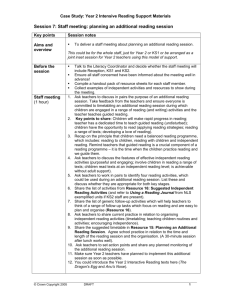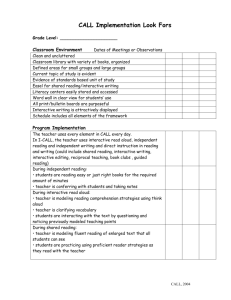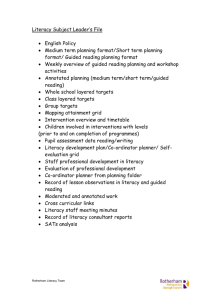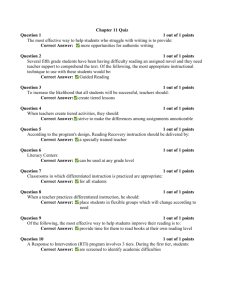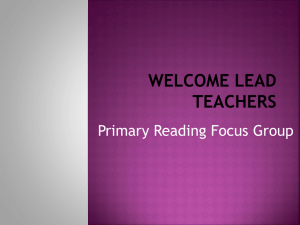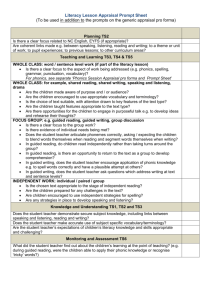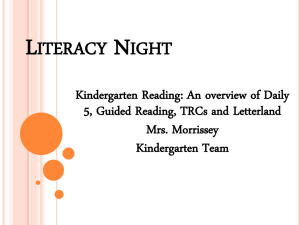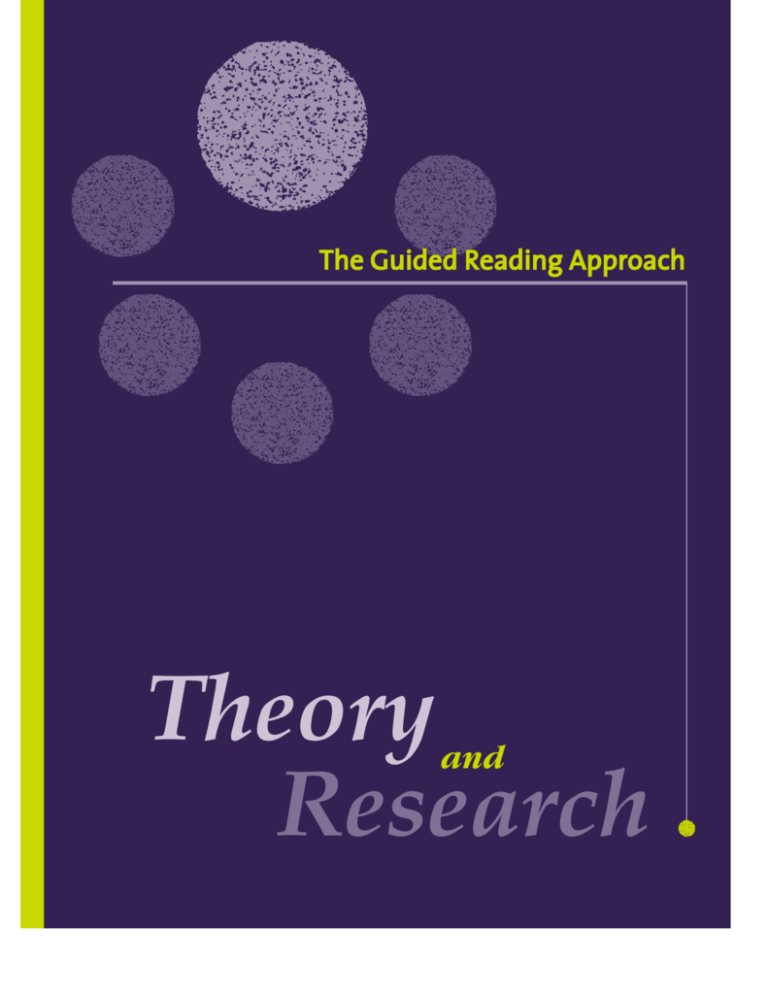
The Guided Reading Approach
Theory
Research
and
Distributed in the United States of America by Pacific Learning,
P.O. Box 2723, Huntington Beach, CA 92647-0723
www.pacificlearning.com
Published 2002 by Learning Media Limited,
Box 3293, Wellington 6001, New Zealand
www.learningmedia.com
Copyright © Learning Media Limited 2002
All rights reserved. Inquiries should be made to the publisher.
Printed in New Zealand
ISBN 0 478 26475 5
PL-9819
Guided Reading: Grounded in
Theoretical Understandings
Jeanne Biddulph
Introduction
How this aligns with the
guided reading process
Guided reading is an important approach in literacy education. Used in
conjunction with other approaches (such as shared reading, reading aloud,
and independent reading), it enables teachers to provide very effective
support for students’ literacy learning.
1. Guided reading enables
teachers to provide very
effective support for students’
literacy learning.
How does guided reading provide such support? What is involved in using
a guided reading approach? A teacher using a guided reading approach
•
•
•
2. The teacher’s role in guided
reading is to actively enhance
students’ understanding.
selects a text that is appropriate for a particular group of students
(usually of similar reading ability),
introduces that text by talking to the students about relevant experiences
that they may have had,
provides sensitive support for the students to “talk, read, and think their
way purposefully through” the text (Reading for Life, 1997, p. 80).
The reading is done silently (or “quietly, to yourself” if the student is an
emergent reader). Discussion of the text before, after, and sometimes during
the reading is central to the approach because the fundamental purpose is to
enhance each student’s understanding of what they are reading.
The teacher’s role in guided reading is to scaffold literacy learning, that is,
to actively enhance students’ understanding. This is in marked contrast to the
practice of merely checking or testing comprehension after a text has been
read by the student. The distinction is critical because, as Dowhower (1999)
reports, there is evidence that many teachers unwittingly assume the role of
interrogators because they tend to confuse assessment with direct teaching
of comprehension. Guided reading is an approach to literacy education that
can help overcome that confusion. It can help teachers refocus on the vitally
important teaching role.
For guided reading to be used effectively, however, teachers need to be
aware of and appreciate the basic understandings or underlying theoretical
perspectives on which the approach is based. Sometimes the view is
expressed that teachers do not need to concern themselves with theory, but
this is not so. Whether teachers (or curriculum developers or curriculum
writers) recognize it or not, all their work has a theoretical basis. From a
professional point of view, it is important to identify and acknowledge the
theoretical perspectives (understandings) that underpin such work. This
paper endeavors to do this with respect to guided reading.
2
The Guided Reading Approach
Basic Understandings That Underpin a Guided
Reading Approach
The theories that underpin guided reading are complex and varied, and
a full discussion of these is well beyond the scope of this paper. Braunger
and Lewis (1998, p. 5), for example, have identified thirteen “core
understandings about learning to read,” all of which have a basis in
research and theory and are significant for classroom literacy programs
in general and relevant to a consideration of guided reading in particular.
This paper considers the six basic understandings that are most directly
relevant and meaningful to a classroom teacher using guided reading at
grades 3–5.
1. Reading is a construction of meaning from written text – it is
an active, cognitive, and affective process
3. Readers build their own
understandings of the author’s
message.
Reading is an interactive process in which readers actively engage with
texts, building their own understanding of the author’s message. The
meaning they make is at the heart of the reading process (Braunger and
Lewis, 1998; Clay, 1991, 1998; Learning Media, 1997; Pressley, 1998).
However, as Pressley points out, although the development of comprehension
is a widely agreed-upon goal of literacy instruction, it “rarely is offered as
systematically as it could be in the elementary grades” (1998, p. 222).
Dowhower (1999) also expresses concern that discussions of text content
and teaching of strategies to enhance comprehension have been rare in
classrooms. Such strategies, Dowhower suggests, should include:
(i)
(ii)
(iii)
(iv)
(v)
(vi)
activating background knowledge,
predicting,
generating visual images,
summarizing,
self-questioning,
analyzing text for story grammar (or story structure) elements (including
narrative story parts, such as character or events, as well as the ways
that content-area texts are organized),
(vii) making inferences,
(viii) distinguishing important information,
(ix) synthesizing,
(x) monitoring, and
(xi) learning to repair faulty comprehension.
This might seem to be a daunting list, but each is an important strategy and,
as Fielding and Pearson (1994, p. 67, cited in Dowhower, 1999) point out,
students are more likely to make these comprehension strategies their own
when they have frequent and systematic opportunities to read and discuss
whole text with a teacher and peers.
The challenge for teachers is to provide these opportunities frequently,
thereby facilitating the development of effective strategies for comprehending
both narrative and expository texts of many kinds (Braunger and Lewis,
1998; Caswell and Duke, 1998; Flippo, 1998). Guided reading is an
approach that is concerned with the development of comprehension.
3
The Guided Reading Approach
It is specifically designed to enable comprehension strategies to be taught
systematically and used by students across a range of texts. The emphasis is
on silent reading because it is more authentic and relevant to real life than
oral reading, and it is also more effective for learning than oral reading,
especially “oral round-robin” reading, which has been shown to decrease
comprehension (Dowhower, 1999).
4. Guided reading is an
approach that is concerned
with the development of
comprehension.
5. Ongoing analysis of individual
students’ strengths and needs
is important.
Because teachers work closely with relatively small groups for guided
reading, they are able to monitor carefully each student’s processing of texts
and adjust further teaching and text selection in the light of their responses.
The importance of this ongoing analysis of individual students’ strengths and
needs is emphasized by various writers (see, for example, Flood, Lapp,
Flood, and Nagel, 1992).
2. Background knowledge and prior experience are critical to
the reading process
The crucial role of prior knowledge in reading is widely recognized
(Anderson and Pearson, 1984, cited in Braunger and Lewis, 1998, p. 28;
Caswell and Duke, 1998) and is often discussed in terms of “schema
theory.” Schema theory attempts to explain how meaning-making occurs
and how knowledge is stored and organized in the brain. According to
Henk (1993), schemata represent the knowledge structures in readers’
minds, and these structures allow readers to connect new information with
what they already know. In his view, “incoming” information either fits into
existing knowledge structures or forces the emergence of new ones. When
readers encounter new examples of things for which they have an existing
schema, they are more likely to make meaningful connections with that new
information than they are if relevant schemata are lacking. Pressley (1998)
also discusses the concept of schema activation, noting that activation can
“dramatically affect” (p. 201) comprehension, attention allocation, and
memory of what is read.
6. Students are more likely to
make meaningful connections
with new information if they
already know something
about it.
When planning and implementing guided reading sessions, teachers are
encouraged to consider the extent to which their students’ existing schemata
match the ideas embedded in the text. Readers must draw from their
existing knowledge in order to understand text (Braunger and Lewis, 1998),
and the meanings they construct will vary somewhat from reader to reader
(Pressley, 1998). Multiple interpretations are generated amongst readers
because their responses to literature are both personal and grounded in text
(Spiegel, 1998).
7. When using guided reading,
teachers need to consider the
extent to which their students’
existing knowledge matches
the ideas in the text.
It is therefore important that teachers develop an awareness of the range
of background knowledge that students bring to school, including their
“overall” prior knowledge and the specific prior knowledge required to
read particular texts (Braunger and Lewis, 1998). Guided reading enables
teachers both to develop this awareness and to cater effectively for the
diversity that is usually revealed. For example, where there seems to be a
close match between the schema of the student and that embedded in the
text, teachers can consciously “activate” students’ relevant schema during
the introduction to guided reading and extend that knowledge during the
reading and the discussion that follows. However, when students’ existing
schemata for a text appear to be limited, judgments need to be made about
8. Guided reading enables
teachers to become aware
of and cater effectively for
the diversity of understanding
that students bring to their
readings.
4
The Guided Reading Approach
whether that particular text should be used for guided reading with those
students or whether an alternative text that is more relevant to their
background knowledge should be sought. In situations where students are
required to read texts for which they have limited schemata, special
teaching strategies are required to develop the background knowledge that
the students bring to the text. Teachers may, for example, provide
introductory activities (such as discussions of photographs, video clips, or
maps) to enhance the students’ background knowledge before they read
and as they guide the group through the text. Alternatively, teachers may
decide to read the text aloud to the students if they think that more teacher
support is required to make the text accessible to the group.
3. Social interaction is essential when learning to read
Interaction with others (both adults and peers) in a wide variety of settings is
an essential part of students’ language and literacy learning (Braunger and
Lewis, 1998; Spiegel, 1998; Wiencek and O’Flahavan, 1994). In fact,
classroom studies show that the amount and breadth of students’ reading is
strongly related to social interaction as well as strategy teaching (Guthrie,
Schafer, Wang, and Afflerbach, 1995).
In Vygotsky’s (1978) view, learning is a “social occurrence” that can be
fostered when teaching is focused in the learner’s “zone of proximal
development.” This zone has been described as the area between the level
at which the student is currently achieving and the level at which the student
can achieve if there is assistance from a more knowledgeable person or, in
Braunger and Lewis’s terms (1998, p. 29), a “more sophisticated other.”
9. Literacy develops best through
social interaction and dialogue
with others.
Because literacy develops best through social interaction and dialogue with
others (Dowhower, 1999), teachers are advised to “scaffold” or support
students’ learning by collaborative means to help them make sense of
literature and become actively engaged in meaning-making more generally
(Dugan, 1997). This is a “social constructivist” view of teaching. It involves
the teacher making a shift from asking predetermined questions designed to
ensure that the students arrive at the “right” meaning to facilitating
conversations that encourage students’ exploratory talk as they arrive at a
deeper meaning (Gavelek and Raphael, 1996).
10. Guided reading is essentially
a carefully managed “social
occurrence.”
These understandings about literacy learning are highly relevant to guided
reading because guided reading is essentially a carefully managed “social
occurrence.” During guided reading, the teacher works to extend the
students’ literacy development by responding sensitively to their efforts and
providing appropriate, ongoing guidance and support as they read (Fountas
and Pinnell, 1996). Within these learning experiences, teachers are
developing not only students’ ability to understand more fully the particular
texts being read but also their ability to use a range of reading and thinking
(metacognitive) strategies when processing other texts they encounter.
Further understandings about the social interaction involved in learning to
read and the need for the “more sophisticated other” to respond sensitively
to the learner are detailed by McNaughton (1995). Drawing on his
research with New Zealand families and the ideas of writers such as
Vygotsky, Heath, and Bronfenbrenner, he discusses students’ early literacy
5
The Guided Reading Approach
learning in terms of a theory of “co-construction.” He stresses the
significance of constant interaction between a student’s own mental
constructions and those of his/her family and cultural group. He argues that
these constructions are a joint outcome of personal and social activities,
which vary considerably from family to family or one community to another.
The effect is that students develop particular kinds of expertise, for example,
some become expert at memorising, some at reading aloud as a
“performance,” and others become skilled at asking questions. According to
McNaughton, the students’ concepts are continually constructed and
changed as a result of their own personal behavior and that of others,
hence the notion of co-construction.
The implications of social constructivist understandings for teachers at all
levels of the school are significant, especially for those supporting the
literacy development of students whose language/cultural backgrounds
differ from their own. To implement guided reading effectively, teachers
need to be fully aware of the nature and impact of the diversity among their
students and seek strategies for catering for this diversity. For example,
extra care is needed to ensure that the texts selected for guided reading and
the processes employed throughout the approach connect with and build on
the students’ existing expertise. When discussing texts, teachers should be
aware that students from diverse backgrounds may not necessarily respond
to questions in ways that teachers expect, not because they “have limited
language” or “lack concentration,” but because their experiences to date
have not yet enabled them to develop the particular forms of expertise and
ways of responding that teachers tend to expect. It is widely acknowledged
that teachers’ expectations can result in judgments about students’
educational potential on the basis of how they behave and talk, thereby
setting up self-fulfilling prophecies that lead to the anticipated differences in
levels of achievement. Wood (1988) says “Crudely, because some teachers
expect less of students from some social backgrounds, these students are
taught and learn less.” Gaining adequate awareness of diversity and then
responding appropriately to that diversity is not an easy task for teachers.
Cazden (1988 and 1992) and Lindfors (1987) explore in detail the
difficulties that arise for students when the language competencies and
expectations they bring to classrooms are not adequately recognized,
understood, or catered for by their teachers.
11. Guided reading helps students
to understand particular texts
and to use a range of reading
and thinking strategies on
other texts.
6
Guided reading is an approach that provides many opportunities both to
support students’ language/literacy development sensitively and carefully
and to develop greater awareness of the particular forms of expertise that
individual students bring to language and literacy experiences. Often there
are subtle but significant differences in the ways in which different students
respond during discussion of texts, and this is evident to the sensitive
listener/observer, particularly during the discussions that follow the guided
reading of a text. Some may respond confidently to teachers’ questions, but
others may have difficulty when “interrogated” or questioned directly by
teachers. Such students may engage more readily and learn more effectively
if the discussion takes the form of a genuine conversation (Wiencek and
O’Flahavan, 1994), especially one in which their questions are encouraged.
In group instruction where students feel safe and secure, they are willing to
take risks, to become more involved, and therefore they gain more
experience and confidence in exploring and articulating their own
The Guided Reading Approach
interpretations of material. In teacher-student discourse, Tierney (1998,
p. 389) notes the need for spaces where “students and teachers connect
or transact with each other, rather than pass by one another. The key is
finding ways to involvement and transaction rather than detachment and
monolithic responses.”
12. Guided reading enables
authentic, ongoing monitoring
of students’ literacy
development.
13. Assessment that emerges from
the classroom rather than
being imposed upon it is
integral to guided reading.
Ongoing observation and monitoring of students’ responses in a range of
learning contexts (including guided and independent reading settings) is of
critical importance to both student and teacher. In fact, it could be argued
that this form of assessment is one of the most “authentic” and valuable of
those available to teachers and that guided reading is an approach that
provides frequent opportunities for such authentic monitoring to take place.
Tierney (1998) suggests that teachers are in a better position to know and
learn about an individual’s development than outsiders because they are
with the student over time and they become aware of the “subtle changes
and nuances of learning within and across learning activities” (p. 377).
Assessment that “emerges from the classroom” rather than being “imposed
upon it” is particularly valuable (Tierney, 1998, p. 375), and this is the form
of assessment that is integral to guided reading. When implemented
effectively, a guided reading approach provides an excellent example of
assessment and teaching operating as integrated processes, each informing
the other to meet the individual needs of students (Braunger and Lewis,
1998, p. 53). It is an approach that also provides opportunities for students
to assess their own learning because they are encouraged, in a supportive
context, to reflect on and articulate what and how they are learning, thereby
building their abilities in metacognitive functioning.
4. Engagement in the reading task is a key to successfully
learning to read
When students want to read, have authentic purposes for reading texts that
are relevant and meaningful to them, and are supported in their reading,
their motivation is usually high (Au, 1997; Johnston, 1997; Spiegel, 1998).
Under such conditions, they will engage much more readily and successfully
in the reading task and associated activities (Cambourne, 1988, 1998;
Flippo, 1998). Cambourne (1998) analyzed the “teaching-learning
activities” that, in his view, lie “at the heart of literacy teaching.” He
suggests that “teaching-learning activities ‘worked’ if
(i) they actively engaged the learners,
(ii) learners learned that which the teachers considered to be important, and
(iii) they promoted collaboration and independence in the learners, thus
providing opportunities for teachers to work one-to-one, or with small
groups, as needed.”
The nature and extent of students’ engagement in literacy learning is critical
because those who enjoy their learning experiences and participate fully in
them are likely to become competent, enduring readers and writers. One of
the important aims of reading programs therefore is to create in students a
positive attitude towards reading (Smith and Elley, 1997), and Tierney
(1998) argues that one focus of literacy assessment should be the extent to
which a student’s interest and engagement are maintained across a range
of materials for different purposes.
7
The Guided Reading Approach
14. Guided reading ensures that
the reading experiences of
students are meaningful,
purposeful, and nonthreatening.
15. Guided reading ensures that
students experience success
and enjoyment so that they will
gradually develop greater
independence and competence.
Meeting these conditions is possible in guided reading sessions because
care is taken to ensure that the reading experiences of students are
meaningful, purposeful, and non-threatening. Groups are small enough
to allow each student to participate fully, and each session provides
opportunities for self-reliance, self-evaluation, and interaction with others.
Guided reading both challenges and supports students. It is designed to
ensure that they experience success and enjoyment so that they will continue
to engage as readers, gradually developing greater independence and
competence. Au (1991), Dugan (1997), and others argue that supportive
patterns of interaction are particularly beneficial to literacy learning.
5. Students learn successful reading strategies in the context of
real reading
In order to construct meaning effectively, students need to learn appropriate
strategies for “orchestrating the information provided at all levels of the four
cueing systems” (Braunger and Lewis, 1998, p. 44), as outlined in section 6
below. Pressley (1998, p. 220) argues that there is “substantial evidence
that elementary students can learn to comprehend actively – they can learn
to predict, question, make mental images, seek to clarify confusions, and
summarize as they read,” and he emphasizes the importance of teachers
modeling this learning.
16. Guided reading requires that
comprehension strategies be
modeled by teachers and that
students be encouraged to use
them independently before,
during, and after their reading
of a text.
Central to guided reading is the understanding that comprehension
strategies will be modeled by teachers and that students will be encouraged
to use them before, during, and after they read a text. When they are
engaged in guided reading, they are solving problems as they read for
meaning and, over time, they will learn to use various strategies across
a range of texts. As they do so, they are supported by the guidance,
demonstrations, and explanations of their teacher (Button, Johnson, and
Furtyerson, 1996). The aim, though, is to encourage students to use these
strategies independently to facilitate their development as readers
(Dowhower, 1999).
In Au’s (1997) view, “authentic” literacy activities (that is, ones that are
real and meaningful for the students involved) are central to a successful
classroom literacy program, especially for students of diverse backgrounds.
The emphasis in guided reading is on “real” reading of “real” texts (of
whatever variety) because teachers seek material that is relevant and
meaningful to the students with whom they are working.
6. Reading involves complex thinking
17. Written language relies on
four cueing systems.
Reading involves using a range of thinking skills in order to make sense
of texts. Although there are many theories about the workings of written
language, Braunger and Lewis (1998, p. 30) confirm that “most are in
agreement that written language relies on four cueing systems, representing
types of knowledge the reader uses as he interacts with text:
(a) pragmatic (social context)
(b) semantic (meaning)
(c) syntactic (structural)
8
The Guided Reading Approach
(d) grapho-phonic (the alphabetic, orthographic, sound symbol aspects).
All of these must be operating in tandem for optimal meaning.”
Smith and Elley (1997, p. 78) also emphasize the way in which various
cues should “interact to help the student achieve a successful understanding
of the author’s message, and by mutual interaction help him/her build up a
repertoire of strategies for doing so efficiently and independently in future.”
Guided reading provides an ideal setting for teachers to encourage students
to use all four sources of information (cueing systems) as they read and to
cross-check one source with others. In the course of regular guided reading
sessions, classroom teachers are able both to develop and monitor these
cross-checking behaviors across a range of increasingly complex texts. Au
(1997) argues that such “skill instruction” can and should take place within
the context of students’ engagement in meaningful activities, emphasizing that
this is particularly important for struggling readers and writers because they
are the ones who “most need to experience ownership of literacy” (p. 187).
18. Guided reading encourages
students to use all four cueing
systems and to cross-check
one source with others.
19. Skill instruction should take
place within the context of
students’ engagement in
meaningful activities.
Making sense of texts is crucial to reading and is an essential session
towards addressing the need for critical thinking and problem solving, a
need that, as Braunger and Lewis (1998) note, is highlighted by current
educational reform. They consider it a daunting challenge to bring all
students, whatever their varying needs, to “high” levels of literacy (p. 63)
and suggest that this challenge involves helping every student to develop:
(a) a firm command of basic skills and strategies,
(b) the ability to construct and negotiate meanings with text,
(c) the knowledge and the disposition to be critical, lifelong readers.
This perspective on literacy is supported, in Braunger and Lewis’s (1998)
view, by models of the reading process that portray reading as thinking.
One such reading as thinking model is that developed by Freebody and
Luke (Luke, 1992; Simpson, 1996). Guided reading fits well into this model.
Freebody and Luke’s perspective could be described as “integrative”
because it combines components of reading that have often been perceived
as separate and mutually exclusive. These components, which are described
as four “key elements of proficient, critical reading as social practice” (Luke,
1992, p. 8), are:
20. Guided reading is integrative.
(i)
Coding competence: learning your role as a code breaker.
How do I crack this?
(ii) Semantic competence: learning your role as text participant.
What does this mean?
(iii) Pragmatic competence: learning your role as text user.
What do I do with this, here and now?
(iv) Critical competence: learning your role as text analyst.
What is this text trying to do to me?
Luke points out that the model is not constructed as a hierarchy in which the
“pragmatic” and “critical” components of reading are seen as “add-ons” to
emerge at upper school levels, if at all. He argues that what he calls a
“socially-critical” literacy program would “systematically introduce students
9
The Guided Reading Approach
to the four elements of reading practice, not hierarchically, not
developmentally, but at all stages of literacy development” (p.11). In fact,
Freebody and Luke believe that it is possible to read in these four roles
simultaneously and that to be a text analyst “does not always imply that
students first have to be skilled readers of complex or sophisticated texts”
(Simpson, 1996, p. 121).
21. Exploring and developing
critical analysis of texts is vital
in literacy development.
22. Regular guided reading
enables critical text analysis
to occur.
Exploring and developing critical analysis of texts is vital in literacy
education, according to Simpson (1996) and many others (for example,
Dowhower, 1999; Learning Media, 1997). Regular guided reading sessions
provide a structure within which this can occur – a structure within which
students can present and discuss their questions about the text. The
approach enables teachers to establish meaningful contexts within which
students can be helped to develop the competencies identified by Freebody
and Luke. Given this kind of systematic support, students can gradually
employ these competencies at increasingly sophisticated levels across a
range of texts. As their competencies grow, so does the likelihood that the
students will become proficient, critical readers.
To appreciate the depth and significance of this perspective on literacy
education, it is necessary to understand that Luke (1992, 1998) emphasizes
both the changing nature of literacy in contemporary societies and the fact
that those who are most literate are those who have the most knowledge
and power in societies. He points out that not all students get equal access
to cultural knowledge and social power via literacy and that in Western
countries, this distribution has continued to fall along the lines of class,
color, and gender. Luke’s view of literacy and its significance in
contemporary society is shared by a number of literacy educators, for
example, Christie (1990), Knobel and Healy (1998), and Tierney (1998).
Tierney notes that “literacy contributes to social transformation as we
connect with what we read and write, not in acquiescence, but in reaction,
reflection, and response” (p. 375).
Teachers seeking to incorporate cultural and critical dimensions as well as
the more “traditional” components of literacy into their work with students
can do so with guided reading. As an approach to literacy education, it has
the capacity to be both consistent with the values of a democratic society
and a means of enhancing those values.
23. Teachers seeking to
incorporate cultural and
critical dimensions as well
as the more traditional
components of literacy can
do so with guided reading.
Conclusion
24. Guided reading is much more
than a set of activities to work
through. An understanding of
the theoretical underpinnings
is essential.
10
Guided reading is, potentially, a very powerful approach that teachers can
use to develop students’ literacy. The extent to which that potential is
reached is determined by a range of factors (some of which may be beyond
an individual teacher’s control, for example, the range of texts available for
use with students). Whatever the constraints, a teacher who understands the
basic theoretical perspectives that underpin the guided reading approach is
in a better position to use it effectively with students than a teacher who
views the approach only as a set of activities to work through.
The Guided Reading Approach
References
Askew, B. and I. Fountas. “Building an Early Reading Process: Active
from the Start,” The Reading Teacher, vol. 52, no. 2 (1998): pp.
126–134.
Gavelek, J. and T. Raphael. “Changing Talk about Text: New Roles
for Teachers and Students.” Language Arts, vol. 73 (1996): pp.
182–192.
Au, K.H. “A Special Issue on Organizing for Literacy Instruction,”
The Reading Teacher, vol. 44, no. 8 (1991): p. 534.
Guthrie, J.T., W.D. Schafer, Y.Y. Wang, and P. Afflerbach.
“Relationships of Instruction to Amount of Reading: An Exploration of
Social, Cognitive and Instructional Connection.” Reading Research
Quarterly, vol. 30, no. 1 (1995): pp. 8–25.
Au, K.H. “Literacy for All Students: Ten Sessions toward Making a
Difference,” The Reading Teacher, vol. 51, no. 3 (1997): pp.
186–194.
Braunger, J. and J. Lewis. Building a Knowledge Base in Reading.
Oregon: Northwest Regional Educational Laboratory’s Curriculum
and Instruction Services, 1998.
Henk, W. “New Directions in Reading Assessment.” Reading and
Writing Quarterly, vol. 9 (1993): pp. 103–120.
Johnston, P. Knowing Literacy: Constructive Literacy Assessment.
York, Maine: Stenhouse, 1997.
Button, K., M. Johnson, and P. Furgerson. “Interactive Writing in a
Primary Classroom,” The Reading Teacher, vol. 49, no. 6 (1996):
pp. 446–454.
Knobel, M. and A. Healy, eds. Critical Literacies in the Primary
Classroom. Newtown, New South Wales: Primary English Teaching
Association, 1998.
Cambourne, B. The Whole Story. Auckland, New Zealand: Ashton
Scholastic, 1988.
Reading for Life. Wellington, New Zealand: Learning Media Limited,
1997.
Cambourne, B. What Makes for an Effective Literacy Activity?
Reading Forum, New Zealand Reading Association, vol. 1 (1998).
Lindfors, J. Children’s Language and Learning. Englewood Cliffs, NJ:
Prentice–Hall, 1987.
Caswell, L. and N. Duke. “Non–narrative as a Catalyst for Literacy
Development.” Language Arts, vol. 75, no. 2 (1998): pp. 108–116.
Luke, A. “Reading and Critical Literacy: Redefining the ‘Great
Debate.’” Reading Forum New Zealand, vol. 21 (1992): pp. 3–23.
Cazden, C. Classroom Discourse: The Language of Teaching and
Learning. Portsmouth, NH: Heinemann Educational Books, 1988.
Luke, A. “Getting over Method: Literacy Teaching as Work in ‘New
Times.’” Language Arts, vol. 75, no. 4 (1998): pp. 305–313.
Cazden, C. Whole Language Plus: Essays on Literacy in the United
States and New Zealand. New York: Teachers College Press, 1992.
McNaughton, S. Patterns of Emergent Literacy. Melbourne, Australia:
Oxford, 1995.
Christie, F. Literacy for a Changing World. Victoria, Australia:
Australian Council for Educational Research, 1990.
Pressley, Michael. Reading Instruction That Works: The Case for
Balanced Teaching. New York: The Guilford Press, 1998.
Clay, M. Becoming Literate: The Construction of Inner Control.
Auckland, New Zealand: Heinemann Education, 1991.
Simpson, A. “Critical Questions: Whose Questions?” The Reading
Teacher, vol. 50, no. 2 (1996): pp. 118–126.
Clay, M. By Different Paths to Common Outcomes. York, Maine:
Stenhouse, 1998.
Smith, J. and W. Elley. How Children Learn to Read. Auckland New
Zealand: Longman, 1997.
Dowhower, S. “Supporting a Strategic Stance in the Classroom: A
Comprehension Framework for Helping Teachers Help Students To
Be Strategic.” The Reading Teacher, vol. 52, no. 7 (1999): pp.
673–683.
Spiegel, D. “Silver Bullets, Babies, and Bath Water: Literature
Response Groups in a Balanced Literacy Program.” The Reading
Teacher, vol. 12, no. 2 (1998): pp. 114–124.
Dugan, J. “Transactional Literature Discussions: Engaging Students in
the Appreciation and Understanding of Literature.” The Reading
Teacher, vol. 51, no. 2 (1997): pp. 86–96.
Flippo, R. “Points of Agreement: A Display of Professional Unity in
Our Field.” The Reading Teacher, vol. 52, no. 1 (1998): pp. 30–40.
Flood, J., D. Lapp, S. Flood, and G. Nagel. “Am I Allowed To
Group? Using Flexible Patterns for Effective Instruction.” The Reading
Teacher, vol. 45, no. 8 (1992): pp. 608–616.
Fountas, I.C. and G.S. Pinnell. Guided Reading: Good First Teaching
for All Children. Portsmouth, NH: Heinemann, 1996.
11
Tierney, R.J. “Literacy Assessment Reform: Shifting Beliefs, Principled
Possibilities, and Emerging Practices.” The Reading Teacher, vol. 11,
no. 5 (1998): pp. 374–390.
Vygotsky, L. Mind in Society. Cambridge, Massachusetts: Harvard
University Press, 1978.
Wiencek, J. and J. O‘Flahavan. “From Teacher–led to Peer
Discussions about Literature: Suggestions for Making the Shift.”
Language Arts, vol. 71 (1994): pp. 488–498.
Wood, D. How Children Think and Learn. New York: Basil Blackwell,
1988.
The Guided Reading Approach
For more information on the guided reading
approach, including student resources and
professional development, visit
www.guidedreading.com or call 800 279 0737.
PL-9819

